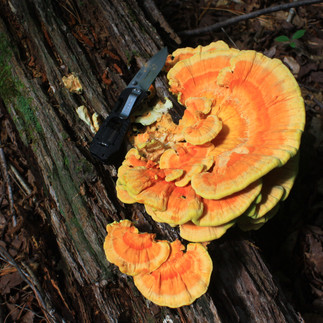Which Edible Mushrooms Should I look for this time of Year?
- Kara Thornton
- May 22, 2022
- 4 min read
Updated: May 23, 2022
During this transitional period from late spring into early summer, quite a few edible mushrooms will start to emerge!
Luckily, with the mushroom we're featuring today, you won't have to search nearly as hard as we all did for morel mushrooms... Everyone else did that right? Just me? Okay lets move on...
Chicken of the woods is commonly known as the one of the 'Fool Proof Four' mushrooms, making it a great place to start for anyone interested in learning to forage edible mushrooms!

There are a few different species that fall under this common name of "Chicken of the Woods" and the beautiful rosette fruiting body featured here is one of them!
SO - how to find & identify these beautiful C.O.W.s?? We'll I'm here to tell ya:
Laetiporus Cincinnatus 05/21/2020
Chapel Hill, NC on a fallen Oak log
First, if you haven't already, take a look at our beginner's guide to foraging here:
There are two main species of Chicken of the Woods that are commonly sought after for edibility:
Laetiporus sulphureus & Laetiporus cincinnatus
Familiarizing yourself with images is a great way to start studying a mushroom! Here, you'll find a gallery of the various Chicken of the Woods specimen's we've found across the United States over the past few years; both L. sulphureus and L. cincinnatus.
Take a look through these images and see if you can spot the main difference between these two species:
If it was too subtle to catch, don't worry! We're learning. The most distinctive difference between these two species is that L. sulphureus has a yellow pore-surface (or underside) and L. cincinnatus has a white pore-surface (or underside). Beyond that, L. cincinnatus is typically more tender than L. sulphureus, plus we've found it growing on scraps of wood buried in leaf litter more often than on trunks, stumps, and logs like L. sulphureus.
Identifying & Foraging 'Chicken of the Woods' Mushrooms:
Know When & Where to Look: Here in the Eastern United States, we can start to see COW as early as May and the season can last through the fall. As with any mushrooms, COW loves rain and summer thunderstorms can create the perfect conditions. These mushrooms are saprobic/saprophytic meaning they consume dead wood as their food source. Hardwood forests with plenty of fallen Oak logs or dead Oak tree stumps are a great place to find these mushrooms.
Learn the Characteristics & Different Species: Before you venture out into nature looking for 'Chicken of the Woods,' be sure to read up on these mushrooms and the different species that may grow in your area. Use your field guides to cross-reference sources, and gain an understanding of the general appearance of these mushrooms.
Study the Pore Surface: You'll find that the species in the Laetiporus genus have distinguishing characteristics such as the pore-surface color. Overall though, the Chicken of the Woods mushroom is known for its soft, smooth porous underside that releases white-colored spores. In our experience, we've encountered L. cincinnatus (the white-pored COW) earlier in the season than L. sulphureus (the yellow-pored COW), which tends to come out later in the season and fruit even through the fall.
Be sure to have a 100% Accurate Identification Before Harvesting: Y'all, I know this can be daunting, but the more you research the more you'll know! It's best to forage with a friend who knows, and to be honest, I'm happy to be that friend, even virtually! If you have a question about a possible Chicken of the Woods mushroom, reach out to us through our email, Instagram, TikTok, YouTube, Facebook etc! We're happy to help.
Responsibly Harvesting Your Chicken of the Woods: This is one of those times you'll really need your knife and basket or paper bag... trust me on this! Be sure to squeeze the shelfs/rosettes of the mushroom to feel for the most tender spots and cut so that you leave the tougher parts behind. Also be sure to inspect for any bug damage and leave those sections behind as well.
Cook THOROUGHLY and Start Small!: If you're new to foraged mushrooms or a specific edible species in general, be sure to always start with small portions. As with all foraged edible mushrooms, be sure to cook these thoroughly before consuming; sauté for at least 10 minutes on medium heat. Note that sautéing with garlic and butter is ALWAYS a great, simple way to enjoy foraged edible mushrooms!
Please note that it is important to identify the substrate (or host tree) you find your COW feeding on!
It's been noted in multiple field guides that Laetiporus huroniensis, a particular species of 'Chicken of the Woods,' may cause stomach upset and therefore its edibility is not necessarily recommended. Though this species does look similar to others, Laetiporus huroniensis feeds only on Conifer wood rather than hardwood and can therefore be distinguished from the others by identifying the host tree. Phew!
.png)






























Comments